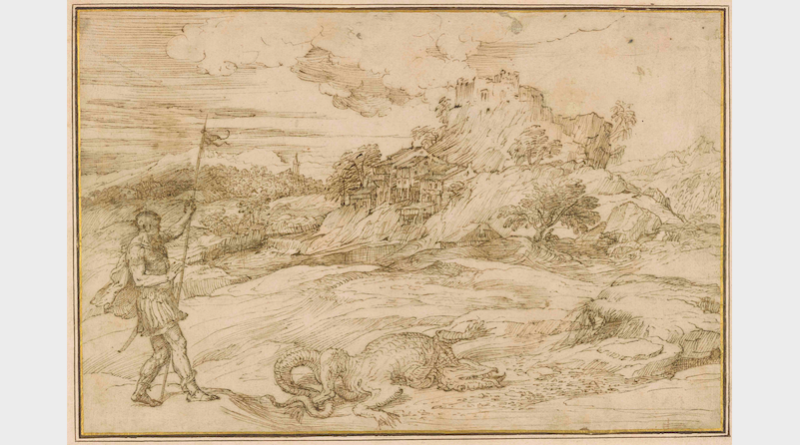REVIEW: ‘The Renaissance of Etching’ at The Met
Image: Attributed to Titian (Tiziano Vecellio) (Italian, ca. 1485/90?–1576). St. George and the Dragon in a Landscape (ca. 1540-55 (?)). Pen and brown ink. Plate: 7 13/16 × 11 5/8 in. (19.8 × 29.6 cm). Morgan Library & Museum. Image courtesy of The Morgan Library & Museum. Provided with permission.
The Renaissance of Etching, an exquisite and meticulous show on display through Jan. 20 at the Metropolitan Museum of Art, brings together some of the greatest etching masterpieces of all time into one exhibition that celebrates the unique art form and articulately showcases its development and history.
It’s only fitting that the exhibition begins with a view of a 16th-century Italian light-calvary armor because etching, defined as drawing on the surface of a metal plate, grew out of the ornately engraved armors of Europe at the time.
After passing by two examples of these engraved armors, viewers have a few rooms to look closely at the European masterworks.
The etching examples begin with German masters in the 15th and 16th centuries. Most striking of these early works is Daniel Hopfer’s “Death and the Devil Surprising Two Women,” from 1515 and also the image deleted for the exhibition catalogue’s cover. Two women look off the paper to the left, while Death is about to overtake one of the figures. He is depicted with a skull in his right hand and an hourglass in the left, while Death lurks by, hovering and waiting for the final deed to be done. The intricacy of the Death and Devil characters is unparalleled and actually frightening to behold, even 500 years after it was first etched.
Another German artist who rightfully commands attention throughout the exhibition is the highly influential Albrecht Dürer, whose works are almost ubiquitous in Met exhibitions (this reporter saw examples simultaneously in Making Marvels and the recently closed The Last Knight). It is no surprise that Dürer receives top billing because his work, etched at the same time as Hopfer’s, was quite impactful in both Germany and throughout the continent.
Dürer’s “A Man of Sorrows” displays his mastery of the etching technique and also his constant tinkering with its output (there are three examples to behold). “Agony in the Garden,” featuring many dark lines except for the central Christ figure, is from the same year as “A Man of Sorrows” and shows a quiet, simple beauty.
Of the Italian examples on display, Parmigianino’s work stands out. Two “Entombment” etches, one with Jesus facing left and the other facing right, offer viewers a clear example of his obvious skills. Ditto for “Woman Resting” from 1527-1530. Many of the other Italian artists featured in the exhibition followed Parmigianino’s work and artistic path, according to press notes.
The final room looks at the other European countries that had solid etching artists. Among the works are Cornelis Anthonisz’s “The Fall of the Tower of Babel” (1547) and Peeter van der Borcht’s “Peasant Fair” (1553), both from the Netherlands. This latter example is intricately detailed with many revelers enjoying a day outside in the main square.
Of the French examples, this reporter responded to Juste de Juste’s “Pyramid of Men” and Léon Davent’s “Venus in Vulcan’s Forge” from 1546-47 (based off Luca Penni’s original). The “Pyramid of Men” etching, in particular, has a DaVinci-like quality, as if Juste were figuring out the mathematical portions of his assembled subjects.
The Renaissance of Etching is a rather big show featuring relatively small objects. The exhibition requires viewers to bend slightly, get close to the art (not too close!) and see the exquisite etching of these Renaissance artists with the naked eye. Their work is bountiful with skill and technique, detail and drama.
By John Soltes / Publisher / John@HollywoodSoapbox.com
The Renaissance of Etching is on view through Monday, Jan. 20 at the Metropolitan Museum of Art in New York City. Click here for more information.

